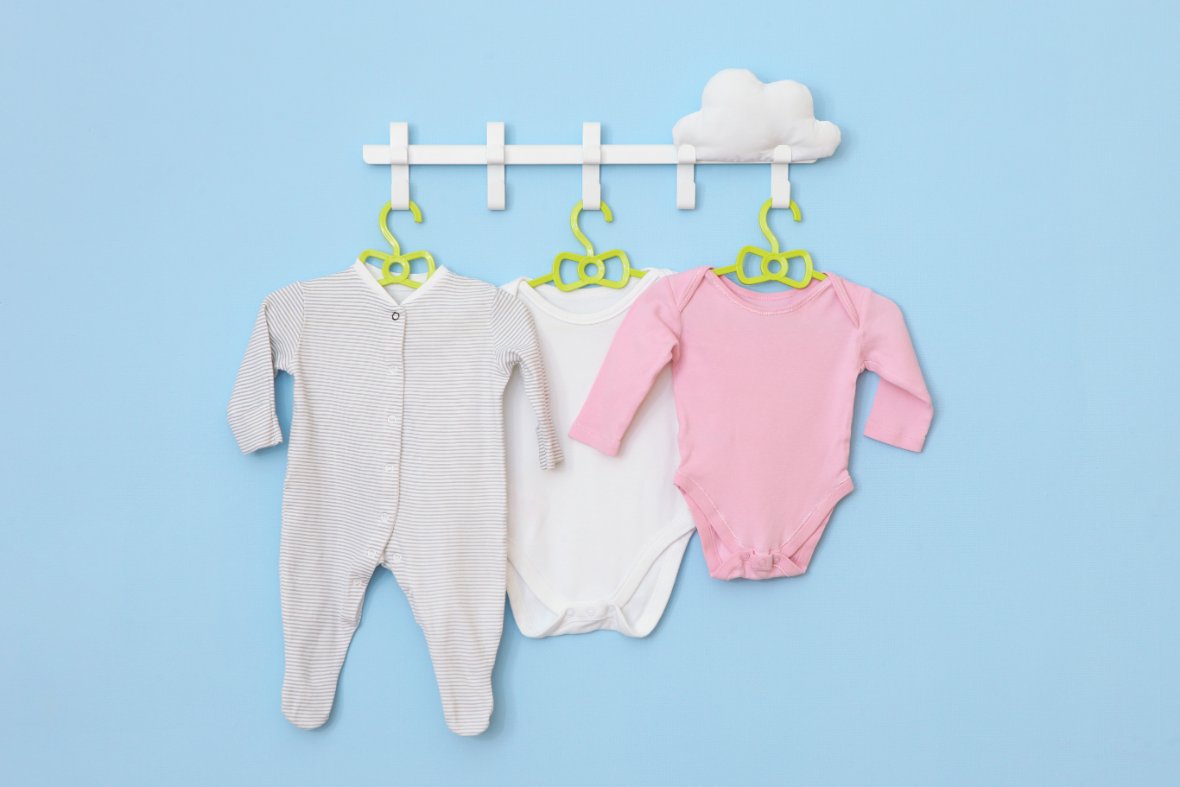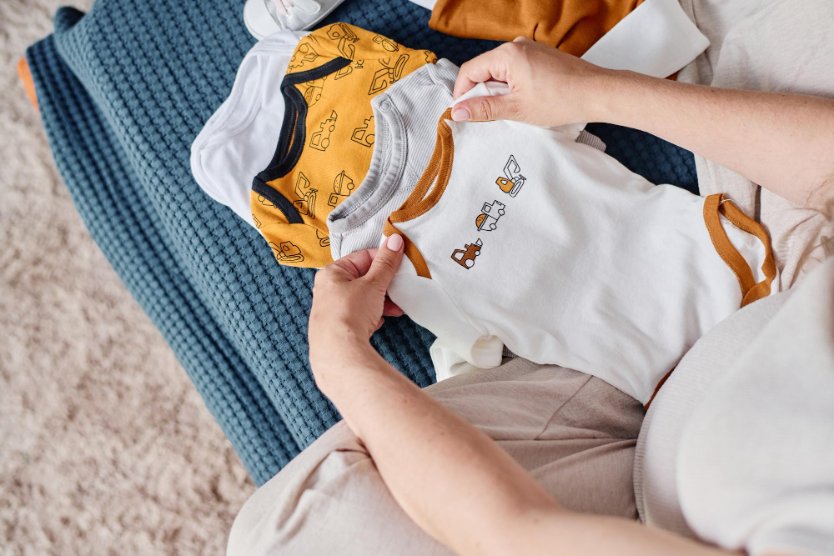Your complete guide to understanding, choosing, and caring for the most essential pieces in your baby’s wardrobe
Table of Contents
- Understanding Baby Rompers and Sleepers
- Safety Standards and Certifications
- Factors to Consider When Choosing
- Pros and Cons of Baby Rompers
- Pros and Cons of Baby Sleepers
- Complete Size Guide and Growth Chart
- Weather Considerations
- Choosing by Developmental Stage
- Care and Maintenance Guide
- Brand Recommendations
- Budget and Shopping Strategy
- Frequently Asked Questions
- Conclusion
Key Takeaways
- Rompers are ideal for warm weather and daytime activities while sleepers provide full coverage for nighttime warmth and comfort
- Safety first: Choose GOTS-certified organic cotton or OEKO-TEX certified fabrics for sensitive baby skin
- Size smartly: Buy slightly larger sizes to accommodate rapid growth spurts in the first year
- Consider developmental needs: Your baby’s mobility and sleep patterns should guide your clothing choices
- Build a balanced wardrobe with both options to ensure you’re prepared for various occasions, seasons, and your growing baby’s changing needs
Understanding Baby Rompers and Sleepers

Dressing babies can be overwhelming with so many clothing options available. Two popular choices that often confuse new parents are rompers and sleepers. Rompers are one-piece outfits that typically have short sleeves and legs, making them perfect for warm weather, while sleepers are designed specifically for bedtime with full coverage and sometimes built-in foot protection for extra warmth.
When comparing these two baby wardrobe essentials, parents need to understand their distinct purposes. Rompers offer style and comfort during active daytime hours, making diaper changes easier with snaps at the bottom. Sleepers focus on keeping your little one cozy throughout the night with features like zippers or snaps along the legs.
Defining Rompers and Sleepers
A baby romper is a one-piece garment that covers the baby’s torso and lower body. Rompers typically have short sleeves and legs, making them ideal for warmer weather. They feature snaps or buttons at the bottom for easy diaper changes.
Most rompers are made from breathable cotton fabric that keeps babies comfortable during play. They come in various designs, from simple monochromatic styles to elaborate patterns.
Baby sleepers, on the other hand, are specifically designed for nighttime use. These one-piece garments usually have long sleeves and full leg coverage, sometimes including built-in feet (footies). Sleepers prioritize warmth and comfort during sleep. They’re available in different fabrics like cotton for warmer months and fleece for colder seasons. Most sleepers have zippers or snaps for convenient diaper access.
History and Evolution in Baby Fashion
Baby rompers have been around since the early 1900s. They were originally designed as play clothes that allowed freedom of movement while keeping babies’ clothing secure. In the 1950s, rompers became popular as everyday wear for infants and toddlers. The design has evolved over decades to include more practical features like reinforced snap closures and stretchy fabrics.
Sleepers evolved from traditional nightgowns. Early versions were simple gowns with drawstrings at the bottom. Modern sleepers now include innovations like two-way zippers for middle-of-the-night diaper changes. Sleep sacks, a variation of sleepers, gained popularity in the 1990s as a safer alternative to blankets.
Today’s infant clothing market offers endless variations of both rompers and sleepers, from organic materials to adaptive designs for babies with special needs.
Safety Standards and Certifications
🛡️ Important Safety Information
Always prioritize safety when choosing baby clothing. Look for certifications and follow current safety guidelines to protect your little one.
Essential Safety Certifications
GOTS Certification (Global Organic Textile Standard): This is the gold standard for organic cotton baby clothing. GOTS ensures that cotton is grown without harmful pesticides and processed without toxic chemicals. The certification covers the entire supply chain from farming to manufacturing.
OEKO-TEX Standard 100: This certification tests for harmful substances in textiles. For baby products (Product Class 1), the testing requirements are the strictest, ensuring the fabric is safe for babies up to 3 years old.
CPSIA Compliance: The Consumer Product Safety Improvement Act requires all children’s products to meet specific safety standards. This includes testing for lead content, phthalates, and other harmful substances.
🛡️ Safety Shopping Tool
Use our comprehensive safe baby clothing shopping checklist to ensure you’re choosing certified, non-toxic clothing for your little one. This interactive tool helps you verify safety standards and certifications before making purchases.
Sleepwear Safety Requirements
According to the American Academy of Pediatrics safe sleep guidelines, babies should sleep on firm, flat surfaces without loose bedding. For sleepwear safety:
- Snug-fitting sleepwear is required for children 9 months to 14 years under CPSC regulations
- Flame-resistant materials are mandated unless the garment fits snugly
- No weighted blankets or sleepers should be used on infants
- Avoid loose-fitting garments during sleep to reduce fire risk
The CPSC children’s sleepwear regulations (16 CFR parts 1615 and 1616) require specific flammability testing and labeling for children’s pajamas and sleepwear.
Safe Design Features to Look For
- Nickel-free snaps: Prevent skin irritation and allergic reactions
- Covered zippers: Protect delicate skin from pinching
- Envelope necklines: Make dressing easier without stretching
- No small decorative elements: Avoid choking hazards like buttons or sequins
- Flat seams: Reduce chafing and irritation
Factors to Consider When Choosing Baby Clothing
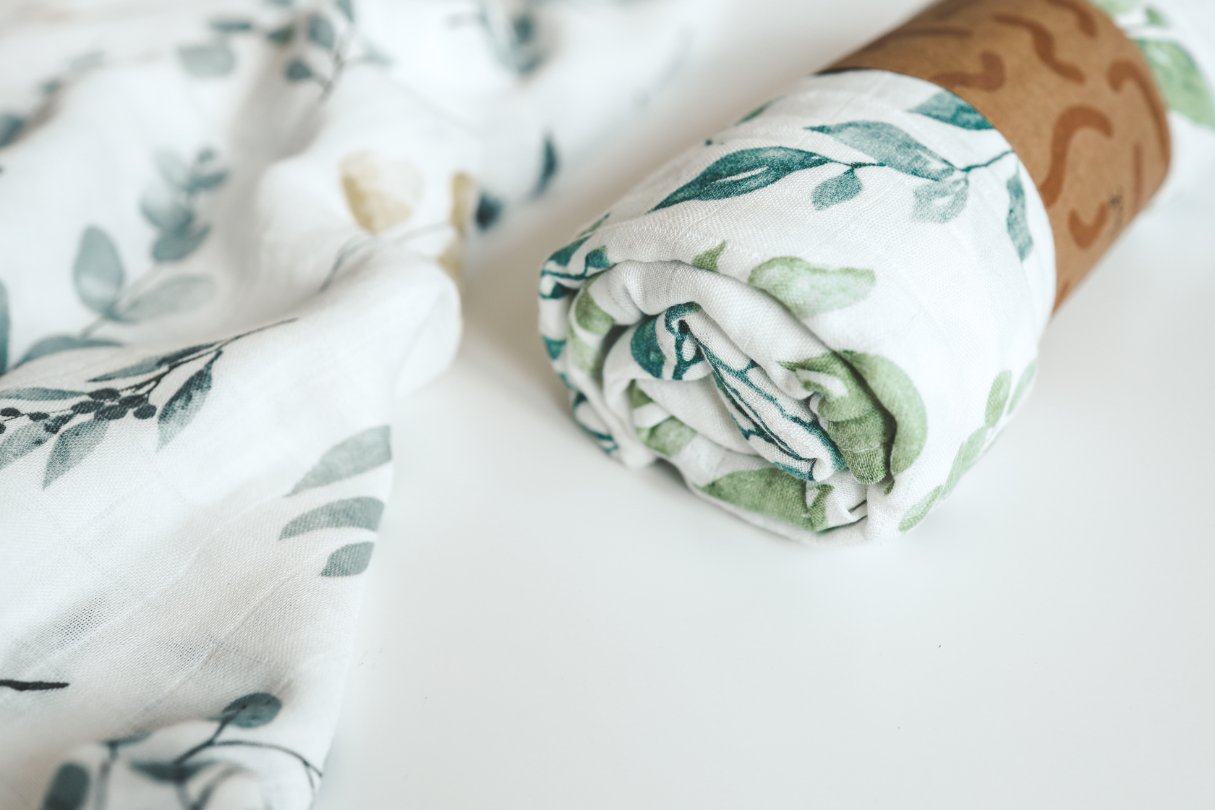
Selecting the right clothing for your baby requires careful thought about comfort, practicality, and growth. Parents should prioritize materials that feel gentle against sensitive skin while ensuring clothes are easy to put on and remove during frequent changes.
Material and Fabric Types
When shopping for baby rompers or sleepers, always check the fabric first. Organic cotton stands out as an excellent choice because it’s free from harmful chemicals and pesticides that might irritate a baby’s skin.
Breathable materials are essential to prevent overheating. Cotton, bamboo, and muslin allow air circulation and help regulate your baby’s temperature. This is particularly important for sleepers since babies wear them for extended periods.
For cooler weather, look for soft fleece or cotton blends that provide warmth without bulk. Stretchy fabrics with some elastane content offer better movement for active babies.
🌱 Organic Clothing Guide
Planning to choose organic options for your baby? Our organic baby clothes checklist by age helps you determine exactly what organic clothing items your baby needs at each developmental stage, from newborn to toddler.
Fabric Care Tips
- Always check clothing labels before purchasing
- Materials should be non-irritating and appropriate for the season
- Pre-wash all new baby clothes before first use
- Use gentle, fragrance-free detergents
Sizing and Fit for Growing Babies
Babies grow incredibly fast, making proper sizing crucial. Experts recommend buying clothes slightly larger than your baby’s current size to accommodate growth spurts.
Adjustable features like expandable waistbands or shoulder snaps can extend a garment’s useful life. Look for rompers with extra snap rows that allow length adjustments.
Consider the closure type carefully. Zippers make quick changes easier, especially during nighttime. However, snaps offer more flexibility for partial openings during diaper changes.
The neckline deserves attention too. Wide or envelope necklines make dressing easier and more comfortable for your baby. Avoid clothing with tight elastic around arms, legs, or waist that might leave marks on your baby’s skin. The fit should be snug enough for safety but roomy enough for comfort and movement.
Pros and Cons of Baby Rompers
Baby rompers offer unique advantages and limitations that parents should consider when building their little one’s wardrobe. These one-piece outfits have several practical features but also come with some challenges depending on your specific needs.
✅ Pros of Baby Rompers
- Easy diaper changes: Snap closures at the crotch allow quick access
- Stay-put design: Won’t ride up like separate pieces
- Versatile styling: Suitable for play, outings, and casual wear
- Complete outfit: No need to coordinate separate pieces
- Temperature regulation: Good airflow for active babies
- Multiple styles: Available in various sleeve and leg lengths
❌ Cons of Baby Rompers
- Layering challenges: Difficult to add or remove layers
- Sizing issues: May be tight in the crotch for tall babies
- Limited winter use: Not ideal for very cold weather
- Toilet training barriers: Less practical for independence
- Full outfit changes: Entire garment needs changing if soiled
- Growth limitations: Outgrown quickly in length
Ease of Diaper Changes with Rompers
Rompers typically feature snap closures at the bottom or between the legs, making diaper changes more convenient than with traditional separates. Many designs include a row of snaps that open completely at the crotch area, allowing you to change diapers without removing the entire outfit.
This feature is especially helpful when you’re on the go or dealing with a squirmy baby. Having to remove pants completely for diaper changes can become frustrating, while rompers eliminate this hassle.
Some higher-end rompers even feature magnetic closures that make diaper changes even faster. However, there can be a learning curve with certain snap patterns, and occasionally snaps may wear out after repeated washings.
Rompers for Versatility and Playwear
Rompers excel as playwear because they stay in place better than separate tops and bottoms. When babies crawl, their shirts often ride up with two-piece outfits, but rompers provide consistent coverage.
These garments come in various styles suitable for different occasions:
- Casual play rompers: Made from durable cotton
- Dressy rompers: Feature embellishments for special events
- Seasonal varieties: Include sleeveless for summer or long-sleeved for cooler weather
Rompers can transition easily from playtime to social outings. Their all-in-one design also means parents don’t need to coordinate separate pieces, simplifying the dressing process.
Challenges with Layering and Weather Adaptability
Despite their benefits, rompers present some limitations when it comes to adaptability. Layering can be tricky since rompers are one-piece garments. Adding or removing layers becomes more complicated than with separates.
Temperature regulation presents another challenge. On changing weather days, you might need to change your baby’s entire outfit rather than just removing a sweater or adding socks.
Some parents find rompers less practical during toilet training stages. Unlike separates that allow children to practice independence, rompers typically require adult assistance for bathroom visits.
Sizing can also be problematic. If your baby has a longer torso or is tall for their age, rompers may fit uncomfortably tight through the crotch area, limiting movement and causing discomfort.
Pros and Cons of Baby Sleepers
Baby sleepers are specialized garments designed for infant sleep time. They provide different benefits and limitations compared to rompers, especially when considering your baby’s comfort and your convenience as a parent.
✅ Pros of Baby Sleepers
- Complete coverage: Keep babies warm from head to toe
- Built-in foot protection: No need for separate socks
- Two-way zippers: Easy nighttime diaper changes
- Sleep-optimized design: Promote better rest
- Temperature regulation: Maintain body heat during sleep
- Swaddle-like comfort: Provide security feeling
❌ Cons of Baby Sleepers
- Restricted movement: Can limit crawling and play
- Overheating risk: Too warm for active daytime use
- Walking development: Foot coverage may delay first steps
- Public diaper changes: More extensive undressing required
- Fabric bunching: Can bunch up during tummy time
- Limited versatility: Primarily designed for sleep
Comfort and Security at Bedtime
Baby sleepers excel in nighttime comfort with their full-body coverage. Most sleepers feature long sleeves and full leg coverage, with many including built-in foot protection. This design helps maintain your baby’s body temperature throughout the night.
The soft fabrics used in sleepers—typically cotton for breathability or fleece for extra warmth—create a cozy environment that mimics the feeling of being swaddled. This can be especially helpful for babies who are transitioning from swaddle blankets.
Sleepers with zipper closures are particularly beneficial for winter nights. The enclosed design prevents your baby’s feet from getting cold, which can disrupt sleep. Some premium sleepers even incorporate gentle compression elements that provide a sense of security similar to a hug, helping many babies settle more easily at bedtime.
Convenience for Parents and Nighttime Changes
Nighttime diaper changes become much simpler with well-designed sleepers. The best options feature:
- Two-way zippers that open from top or bottom
- Magnetic closures for silent, quick changes
- Snap buttons along the inside of legs for easy access
Sleepers eliminate the need for separate pieces of clothing, reducing laundry and simplifying your baby’s bedtime routine. Most baby sleepers are designed as complete pajama sets, so you don’t need to coordinate tops and bottoms. This saves precious time during those middle-of-the-night wakings when you’re operating on minimal sleep.
For breastfeeding mothers, sleepers with strategic openings can make nighttime feedings less disruptive while keeping your baby cozy and warm.
Limitations for Active Play and Day Use
While excellent for sleep, baby sleepers have some drawbacks for daytime wear. The full coverage that makes them perfect for bedtime can restrict movement during active play.
Sleepers tend to be warmer than separate clothing pieces, which might make your baby uncomfortable during daytime activities, especially in warmer weather or heated indoor environments.
Diaper checks become less convenient in public settings when using a sleeper, as they typically require more extensive undressing than two-piece outfits.
Sleepers with foot coverings can delay walking development in some babies, as they don’t allow for direct foot contact with surfaces when your little one is practicing standing.
For babies who enjoy tummy time and crawling, the extra fabric in sleepers sometimes bunches up around the neck or creates friction against the floor.
Complete Size Guide and Growth Chart
Understanding baby clothing sizes is crucial for ensuring comfort and getting the most wear from each garment. Baby clothing sizes can vary significantly between brands, making it important to focus on weight and height measurements rather than age alone.
| Size | Age Range | Weight (lbs) | Height (inches) | Best For |
|---|---|---|---|---|
| Preemie | 0-4 weeks | Up to 6 lbs | Up to 17″ | Premature babies |
| Newborn | 0-4 weeks | 6-8 lbs | 17-19″ | First few weeks |
| 0-3 months | 0-3 months | 8-12 lbs | 19-23″ | Rapid growth period |
| 3-6 months | 3-6 months | 12-16 lbs | 23-26″ | Increased mobility |
| 6-9 months | 6-9 months | 16-20 lbs | 26-28″ | Sitting, crawling |
| 9-12 months | 9-12 months | 20-24 lbs | 28-30″ | Standing, first steps |
| 12-18 months | 12-18 months | 22-28 lbs | 30-32″ | Walking, toddling |
| 18-24 months | 18-24 months | 28-32 lbs | 32-35″ | Active toddler |
Smart Sizing Tips
When shopping for baby clothes, consider these expert recommendations:
- Size up when in doubt: Babies can grow into clothes but can’t wear items that are too small
- Buy fewer newborn sizes: Most babies outgrow newborn clothes within 4-6 weeks
- Stock up on 0-3 and 3-6 month sizes: These sizes typically last longer
- Check brand-specific charts: Sizing varies significantly between manufacturers
- Consider the season: Buy appropriate sizes for when your baby will actually wear them
Growth Accommodation Features to Look For
- Adjustable shoulder snaps: Allow for head circumference growth
- Expandable waistbands: Accommodate weight fluctuations
- Fold-over mittens: Extend sleeve length as baby grows
- Two-way stretch fabric: Provides flexibility for movement
When to Size Up
Watch for these signs that indicate it’s time to move to the next clothing size:
- Snaps are difficult to fasten or strain when closed
- Sleeves or legs appear too short
- Neckline seems tight or leaves marks
- Baby appears uncomfortable or restricted in movement
- Fabric pulls or stretches across the chest or belly
Weather Considerations for Baby Outfits
Weather plays a crucial role in choosing the right clothes for your baby. The right outfit keeps your little one comfortable and helps prevent problems like overheating or getting too cold.
Dressing for Warm and Hot Weather
In warm weather, lightweight rompers are a perfect choice. They provide full coverage while allowing air to circulate around your baby’s body.
Best warm weather options:
- Short-sleeved or sleeveless rompers
- Cotton bubble rompers (excellent for air flow)
- One-piece outfits without feet
- Lightweight muslin or bamboo fabrics
Look for rompers made from breathable fabrics like cotton. These materials wick moisture away from your baby’s skin and prevent heat rash. Avoid overdressing your baby when it’s hot. A simple romper is often enough – no need for undershirts or additional layers. For very hot days, a diaper and light romper is sufficient.
⚠️ Hot Weather Safety
Never leave babies in cars during warm weather, even for short periods. Signs of overheating include flushed skin, rapid breathing, and fussiness. Keep babies in shade and ensure adequate hydration through breast milk or formula.
Clothing Options for Cold Weather
Cold weather calls for layering and warmer materials to keep your baby cozy.
Cold weather essentials:
- Long-sleeved rompers or onesies as a base layer
- Sleepers with feet for complete coverage
- Rompers made from thicker materials like fleece
- Sleep sacks or wearable blankets for nighttime
Footed sleepers are especially helpful in cold weather since baby socks rarely stay on. Look for options with diagonal or front zippers, which make diaper changes easier.
For very cold days, start with a onesie, add a warm romper, and finish with a sleep sack or wearable blanket. This layering approach lets you adjust your baby’s clothing based on the indoor temperature, which can fluctuate throughout the day.
Transitional Weather Solutions
Spring and fall weather can be unpredictable. Here’s how to dress your baby for changing conditions:
- Layer smartly: Start with a base layer (onesie) and add removable pieces
- Bring backup clothes: Pack both lighter and warmer options
- Choose versatile pieces: Long-sleeved rompers work for various temperatures
- Consider time of day: Mornings may be cool while afternoons are warm
📅 Seasonal Planning Tool
Stay ahead of seasonal clothing needs with our seasonal baby clothing timeline planner. This interactive tool helps you plan and organize your baby’s wardrobe throughout the year, ensuring you have the right clothes ready for each season.
Choosing by Developmental Stage
Your baby’s developmental stage significantly impacts their clothing needs. As babies grow and become more mobile, their clothing requirements change to support their new abilities and safety needs.
| Stage | Age Range | Best Clothing Options | Key Considerations |
|---|---|---|---|
| Newborn | 0-3 months | Sleep gowns, footed sleepers, simple rompers | Easy diaper access, temperature regulation, gentle fabrics |
| Infant | 3-6 months | Short-sleeve rompers, lightweight sleepers | Allow for increased movement, breathable materials |
| Mobile Baby | 6-12 months | Snap-bottom rompers, separates for crawling | Knee protection, non-slip feet, durability |
| Toddler | 12+ months | Two-piece outfits, easy-on rompers | Independence, potty training preparation |
Newborn Stage (0-3 months)
What works best: During the newborn stage, prioritize ease of dressing and diaper changes. Sleep gowns with elastic bottoms are excellent for nighttime, while simple rompers work well for daytime.
Key features to look for:
- Envelope necklines for easy head insertion
- Side-snap or front-opening designs
- Soft, non-irritating seams
- Built-in mittens to prevent scratching
Infant Stage (3-6 months)
What works best: As babies become more alert and begin to move more, choose clothing that allows for increased mobility while maintaining comfort.
Key features to look for:
- Stretchy fabrics that move with baby
- Snap closures at the crotch for easy changes
- Reinforced knees for tummy time
- Non-restrictive armholes
Mobile Baby Stage (6-12 months)
What works best: Crawling and exploring babies need durable, flexible clothing that can withstand increased activity.
Key features to look for:
- Knee reinforcements or padding
- Non-slip soles on footed items
- Separates for easier diaper changes
- Fabrics that wash well and resist stains
Toddler Stage (12+ months)
What works best: As children develop independence, choose clothing that supports their growing autonomy.
Key features to look for:
- Easy-on/off designs for self-dressing practice
- Two-piece outfits for potty training
- Elastic waistbands
- Velcro or large buttons for fine motor skill development
Care and Maintenance Guide
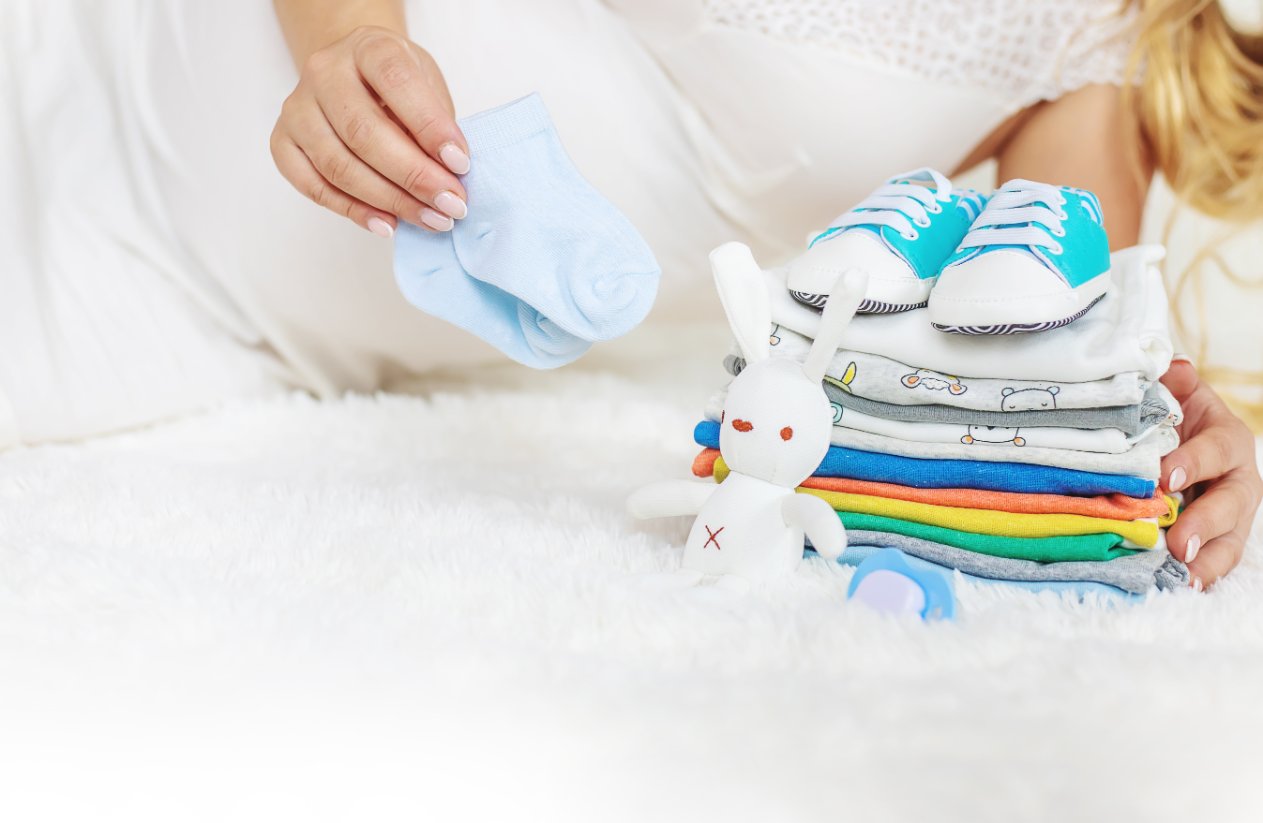
Proper care extends the life of baby clothes and keeps them soft and safe for your little one’s delicate skin. With frequent washing due to spit-ups, diaper leaks, and food messes, knowing how to care for different fabrics is essential.
Washing Instructions by Fabric Type
Cotton Care
- Temperature: Warm water (30-40°C) for regular washing
- Detergent: Use gentle, fragrance-free baby detergent
- Drying: Air dry when possible to prevent shrinkage
- Ironing: Medium heat if needed
Bamboo Care
- Temperature: Cold to lukewarm water
- Detergent: Mild, eco-friendly detergent
- Drying: Air dry to maintain softness
- Special note: Avoid fabric softeners
Fleece Care
- Temperature: Cool water to prevent pilling
- Detergent: Gentle detergent, no fabric softener
- Drying: Low heat or air dry
- Special note: Wash inside out
Stain Removal for Baby Messes
Baby clothes face unique staining challenges. Here’s how to tackle common stains:
Spit-up and formula stains:
- Rinse immediately with cold water
- Pre-treat with enzyme-based stain remover
- Soak in cold water for 30 minutes before washing
- For stubborn stains, try a paste of baking soda and water
Food stains:
- Scrape off excess food gently
- Rinse with cold water from the back of the fabric
- Apply liquid detergent directly to the stain
- Let sit for 10-15 minutes before washing
Diaper leaks:
- Rinse thoroughly in cold water
- Pre-soak in enzyme detergent solution
- Verify complete removal before drying
- Consider using oxygen bleach for white items
Preserving Fabric Softness
Keeping baby clothes soft is important for comfort and preventing skin irritation:
- Use white vinegar: Add 1/2 cup to the rinse cycle as a natural softener
- Avoid over-drying: Remove clothes while slightly damp
- Choose gentle detergents: Harsh chemicals can make fabrics stiff
- Shake out clothes: Before hanging or folding to maintain texture
Storage Tips for Seasonal Clothing
Proper storage helps preserve clothes for future use or hand-me-downs:
- Clean thoroughly: Wash and completely dry before storing
- Use breathable containers: Cotton bags or cardboard boxes work well
- Add lavender sachets: Natural moth deterrent with pleasant scent
- Label by size: Makes retrieval easier later
- Check periodically: Ensure no moisture or pest issues
Brand Recommendations and Quality Guide
Choosing quality brands ensures better durability, safety, and comfort for your baby. Here are top-rated brands organized by budget and specialty.
Premium Organic Brands
Burt’s Bees Baby
Specialty: GOTS-certified organic cotton
Price range: $15-45
Best for: Sensitive skin, everyday wear
Hanna Andersson
Specialty: Premium organic sleepwear
Price range: $25-60
Best for: Long-lasting quality, gift-giving
Monica + Andy
Specialty: Stylish GOTS-certified basics
Price range: $18-50
Best for: Modern designs, minority-owned business
Budget-Friendly Quality Options
Carter’s
Specialty: Affordable basics and sets
Price range: $8-25
Best for: Building a complete wardrobe
Gerber
Specialty: Onesies and essential basics
Price range: $5-20
Best for: Stock-up items, newborn essentials
Simple Joys by Carter’s
Specialty: Amazon exclusive value packs
Price range: $12-30
Best for: Bulk purchasing, basic needs
Specialty and Innovation Brands
Kyte Baby
Specialty: Bamboo rayon sleepwear
Price range: $20-45
Best for: Temperature regulation, eczema-prone skin
Little Sleepies
Specialty: Stretchy bamboo pajamas
Price range: $25-40
Best for: Comfort, unique prints
Magnetic Me
Specialty: Magnetic closure technology
Price range: $30-55
Best for: Quick changes, convenience
What to Look for in Quality Brands
- Certification credentials: GOTS, OEKO-TEX, or CPSIA compliance
- Reinforced construction: Double-stitched seams and quality hardware
- Transparent sourcing: Clear information about materials and manufacturing
- Size consistency: Reliable sizing across their product line
- Warranty or guarantee: Stand behind their product quality
📊 Brand Comparison Tool
Need help choosing between different baby clothing brands? Our safe baby clothing brands comparison tool lets you compare safety certifications, materials, price points, and user reviews across top baby clothing brands to make informed decisions.
Budget and Shopping Strategy
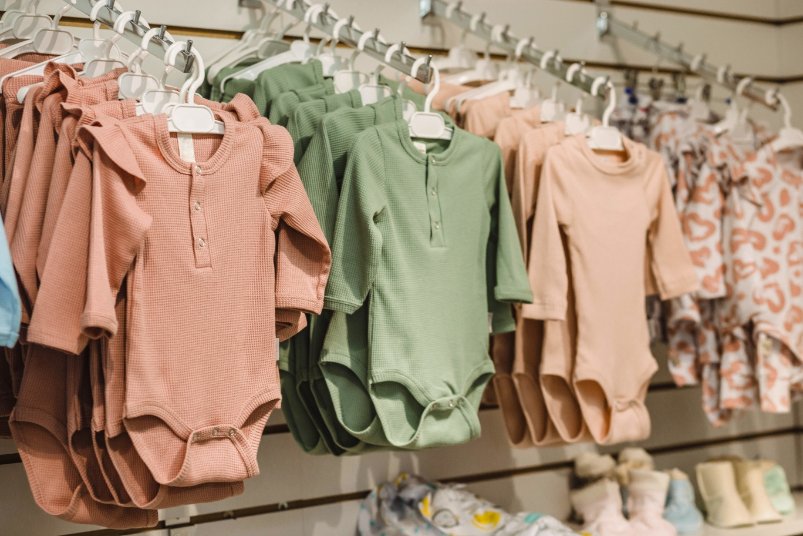
Building a functional baby wardrobe doesn’t have to break the bank. With smart shopping strategies and careful planning, you can ensure your baby has everything they need while staying within budget.
Essential Quantities by Age
| Age Range | Rompers/Onesies | Sleepers | Daily Changes | Shopping Priority |
|---|---|---|---|---|
| Newborn (0-3 months) | 6-8 pieces | 4-6 pieces | 2-3 outfits + 1 sleeper | Don’t overbuy, rapid growth |
| Infant (3-6 months) | 8-10 pieces | 5-7 pieces | 1-2 outfits + 1 sleeper | Focus on versatile pieces |
| Mobile (6-12 months) | 10-12 pieces | 6-8 pieces | 1-2 outfits + 1 sleeper | Invest in durability |
| Toddler (12+ months) | 8-10 pieces | 4-6 pieces | 1 outfit + pajamas | Mix separates with rompers |
Cost-Saving Shopping Tips
Timing your purchases:
- End-of-season sales: Buy next size up in off-season clothing
- Back-to-school season: Great deals on basics in August/September
- Post-holiday clearance: January sales for winter items
- Black Friday/Cyber Monday: Stock up on essentials
Smart shopping strategies:
- Buy in bulk: Multi-packs offer better value per piece
- Mix and match approach: Choose coordinating colors for versatility
- Focus on basics: Invest in quality essentials, save on trendy pieces
- Consider secondhand options: Gently used baby clothes offer great value
Registry Recommendations
When creating a baby registry, balance immediate needs with future growth:
Essential registry items:
- 2-3 newborn sleepers (people often gift these sizes)
- 6-8 onesies in 0-3 month size
- 4-5 rompers in 3-6 month size
- 2-3 sleepers in 6-9 month size
- Mix of short and long-sleeve options
Registry tips for gift-givers:
- Include a variety of sizes, not just newborn
- Add seasonal considerations to your registry notes
- Specify preferred brands or certifications
- Include care instructions preferences
Cost-Per-Wear Analysis
When evaluating clothing purchases, consider the cost per wear:
- High-use items: Invest more in sleepers and basic onesies
- Special occasion items: Buy budget-friendly options for rarely worn pieces
- Growth considerations: Faster-growing babies need more frequent size changes
- Seasonal timing: Consider how long the item will be weather-appropriate
Frequently Asked Questions
Conclusion
Choosing between baby rompers and sleepers doesn’t have to be an either-or decision. Both play essential roles in your baby’s wardrobe, serving different purposes throughout their development. Understanding when and how to use each type will help you make informed decisions that prioritize your baby’s comfort, safety, and your convenience as a parent.
Essential Takeaways
Rompers excel for daytime activities – their breathable design, easy diaper access, and stay-put construction make them perfect for active play, outings, and warm weather. They’re particularly valuable from 3 months onward when babies become more mobile and engaged with their environment.
Sleepers are nighttime champions – their full coverage, temperature regulation, and sleep-optimized features provide the comfort and warmth babies need for quality rest. From newborn through toddler stages, the right sleeper can significantly improve sleep quality for both baby and parents.
Safety must always come first – regardless of style preference, prioritize GOTS-certified organic cotton or OEKO-TEX certified fabrics, ensure proper fit without restriction, and follow current AAP safe sleep guidelines. For sleepwear, compliance with CPSC safety standards is non-negotiable.
Building Your Baby’s Wardrobe
Start with quality basics in essential sizes, focusing more on 0-3 and 3-6 month sizes rather than newborn items. Invest in versatile pieces that can transition between seasons and activities. Consider your lifestyle – active families may prefer more rompers, while families prioritizing sleep routines might invest more heavily in quality sleepers.
Remember that every baby is different. Some prefer the freedom of rompers, while others find comfort in the security of full-coverage sleepers. Pay attention to your baby’s cues and adjust your clothing choices accordingly.
Smart Shopping Strategy
Balance quality with budget by investing in items your baby will wear most frequently. Proper care and maintenance will extend the life of both rompers and sleepers, making quality purchases more cost-effective over time.
Don’t forget about hand-me-down potential – well-made rompers and sleepers can serve multiple children, making the initial investment even more worthwhile.
Final Thoughts
The rompers versus sleepers decision ultimately comes down to understanding your baby’s needs at different times and stages. By building a thoughtful wardrobe that includes both options, you’ll be prepared for every situation – from active playtime to peaceful sleep, from warm summer days to cozy winter nights.
Trust your instincts as a parent, prioritize safety and comfort above all else, and remember that the “perfect” choice is simply the one that works best for your family’s unique situation. With the information provided in this guide, you’re well-equipped to make confident decisions about your baby’s clothing needs.
For additional guidance on baby clothing care and safety, explore our comprehensive resources on hypoallergenic baby clothing and organic versus conventional infant clothing to ensure your little one stays comfortable, safe, and stylish throughout their early years.

